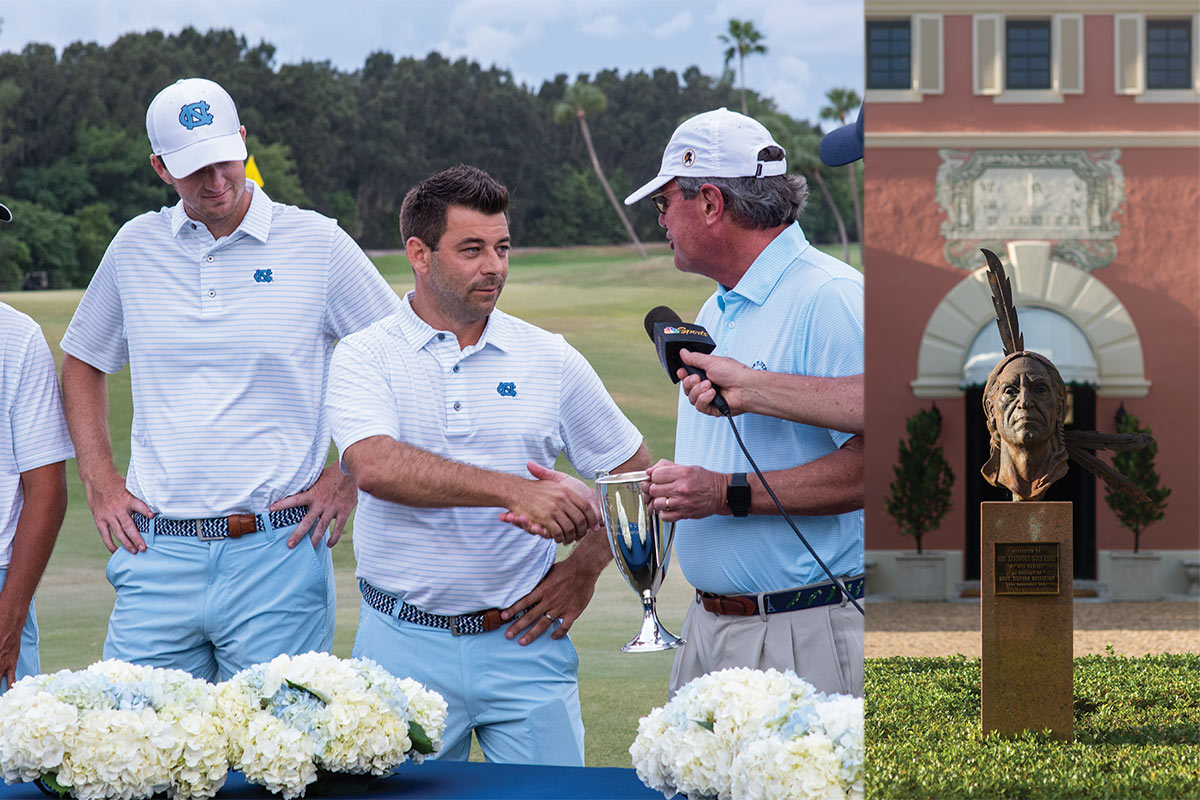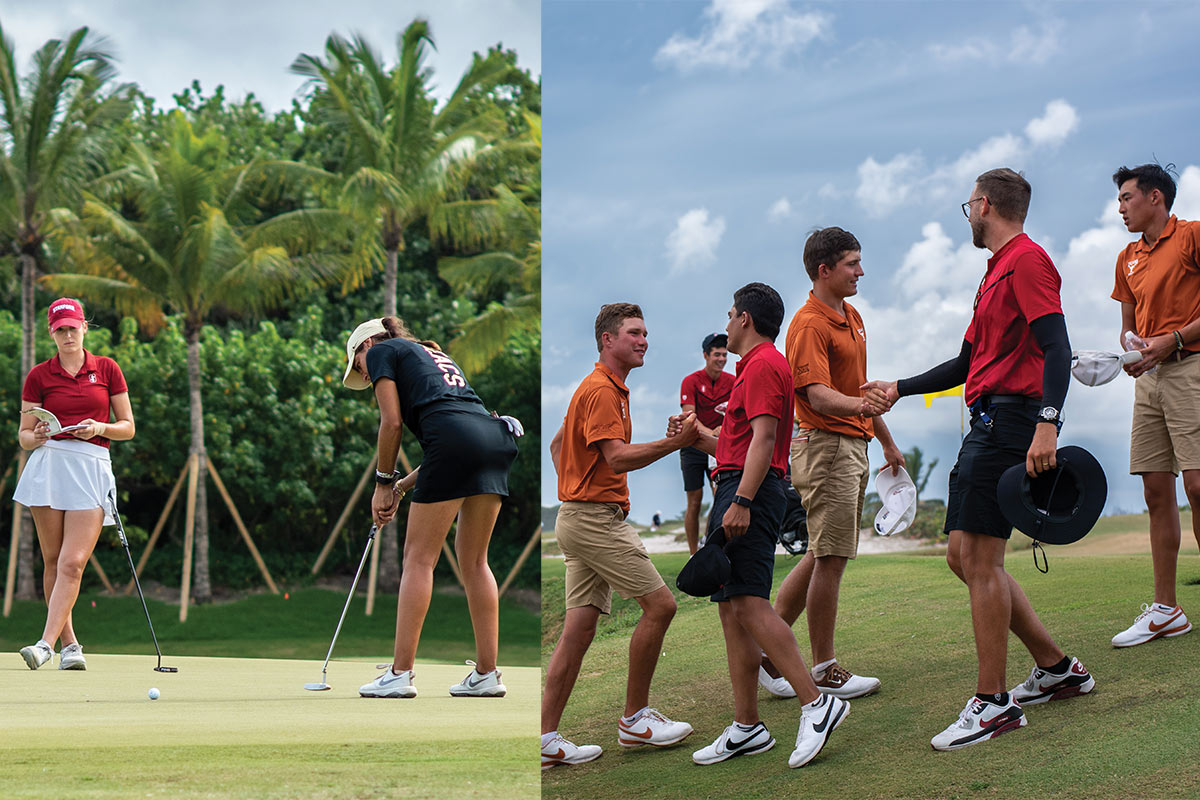
tanding in front of the iconic Seminole Golf Club this October, surrounded by the game’s history and future, Warren Stephens smiled. “It seems like it’s all going right,” he told Kingdom. And it was. The second staging of the Jackson T. Stephens Cup had just concluded successfully, with University of North Carolina earning the men’s team victory, Stanford the women’s, and two individual champions—Wake Forest’s Rachel Kuehn and UNC’s David Ford—emerging as well. Expectedly, given the quality of the competing teams, the golf was top-notch, but there was more to the tournament than skilled play, as Stephens explained to us some time ago.
Speaking after the inaugural event at Stephens’ Alotian Club in Arkansas, he said an important part of his aim with the tournament was to showcase the values championed by his father, Jackson T. Stephens, a former chairman of Augusta National Golf Club.
“Dad truly believed that golf instilled life lessons and built character,” Warren said, “especially when started young. Therefore, he would be very humbled and proud that this tournament is named in his honor.”
With the quality of golf and sportsmanship on display at Seminole, the elder Stephens would have been proud indeed. More than just an opportunity to experience real competition, the Stephens Cup, as it is known, offers elite college players the chance to compete at luminary venues, on television, and in formats that challenge the best in the game. The tournament features seven of the top NCAA Division 1 men’s and women’s teams in the country, as well as standout players from U.S. Military Service Academies and Historically Black Colleges and Universities competing as individuals.
“We talk about trying to provide our student athletes with incredible experiences, and that’s exactly what they got here,” said UNC Coach Andrew DiBitetto. “It was a first-class event, an unbelievable place like Seminole, so it was a special week all the way around.”
The course, a legendary venue in the golf world, was designed by Donald Ross in 1929. Standing with one’s back to the iconic clubhouse, the entire golf course is basically in view, the sand dune ridges, elevated greens and general contours all in sight.

“I would say that South Florida, more open style of golf, isn’t historically my favorite, but that design was fantastic,” said FSU golfer Cole Anderson, who picked up a point for the Seminoles, despite his team finishing runner-up. “All of us really appreciated the classic layout and that there was not a whole lot of dirt-moving going on, like you can see nowadays. You could see that they had taken the blank canvas and shaped the course into the natural landscape. It was a really cool experience to compete at a club like that, with all of the history and the members that have gone through there and all of the great events.”
Stephens said the enhanced experience is intentional, that the tournament is meant to provide participants with more than just another competition.
“Any time you get to play a golf course like Seminole that’s so well known in the golf world, and everyone knows it’s one of the great courses in the world, it’s special,” he said. “So they’re experiencing something very few people get to experience.”

Acclaimed University of Texas Coach John Fields understood that as much as anyone.
“This is a lifetime experience for our guys,” Fields said. “To get to come to Seminole with all the history and tradition at this club, the Donald Ross golf course, Ben Hogan associated with it… We all knew we were someplace special; we’re happy we got a chance to do it. We’re kind of a young team, so it was a good opportunity to get some match play under our belt. Although we didn’t come out victorious, I think we got a lot from it.”
The format—54 holes of stroke play followed by 18 holes of match play—was featured live on Golf Channel (another unique and potentially once-in-a-lifetime experience for some participants), and while it was a good time for all concerned, it was by no means easy, especially given the two rounds required on the second day of competition.
“Any time there’s 36 holes in a day involved you try and make sure that physically you’re conditioned and rested,” said FSU’s Anderson. “But at the same time, I don’t really care who you are, 10 hours of golf consecutively is tiring.”

To survive such a test, Anderson said, his coach told him to stay in the moment.
“The biggest thing coach always gives to me, he reminds me to ‘stay where your feet are,’” Anderson said. “Kind of a funny saying, but it makes a lot of sense: Keep your head exactly where you are, don’t let your mind wander. ‘If I do this over this next stretch, this could happen.’ Or ‘if the team does this, we could make it through to this.’ Stay where your feet are.’ That’s sort of the thing I lean on the most.”
When Wake Forest University’s Rachel Kuehn won the women’s individual, her teammates doused her in water—not uninvited on a hot October afternoon in South Florida. Her win put her team into contention for the team final, way out in front before the last day of play, but Stanford’s brilliant play eventually saw its women’s team take the win. Likewise, UNC and FSU came down to the wire in the men’s. At the end of it all, while the teams and players clearly will have their own emotions, as an observer it was hard to see that anyone lost. The hugs and handshakes that were exchanged after play appeared sincere, the smiles in the parking area genuine, and the attitude all around felt positive.

As elite as the college game is these days, the Jackson T. Stephens Cup still distinguishes itself among the other events. Next year’s will be played at Trinity Forest in Dallas, and the year after that will be at Oklahoma City Golf and Country Club. Wherever it’s held, the event resonates as a special moment on the calendar, as UNC’s Coach DiBitetto underlined:
“So far already this year we’ve played at Notre Dame’s golf course, which is fantastic and hosted the U.S. Senior Open not too long ago, and then we went to Olympia Fields, which is a major championship golf course, then we went to Colonial, a PGA Tour golf course, and then here. So college golfers these days are a little bit spoiled.” But as for the Stephens, he said: “This one is very special.”

Follow Us On


| Cookie | Duration | Description |
|---|---|---|
| cookielawinfo-checkbox-analytics | 11 months | This cookie is set by GDPR Cookie Consent plugin. The cookie is used to store the user consent for the cookies in the category "Analytics". |
| cookielawinfo-checkbox-functional | 11 months | The cookie is set by GDPR cookie consent to record the user consent for the cookies in the category "Functional". |
| cookielawinfo-checkbox-necessary | 11 months | This cookie is set by GDPR Cookie Consent plugin. The cookies is used to store the user consent for the cookies in the category "Necessary". |
| cookielawinfo-checkbox-others | 11 months | This cookie is set by GDPR Cookie Consent plugin. The cookie is used to store the user consent for the cookies in the category "Other. |
| cookielawinfo-checkbox-performance | 11 months | This cookie is set by GDPR Cookie Consent plugin. The cookie is used to store the user consent for the cookies in the category "Performance". |
| viewed_cookie_policy | 11 months | The cookie is set by the GDPR Cookie Consent plugin and is used to store whether or not user has consented to the use of cookies. It does not store any personal data. |